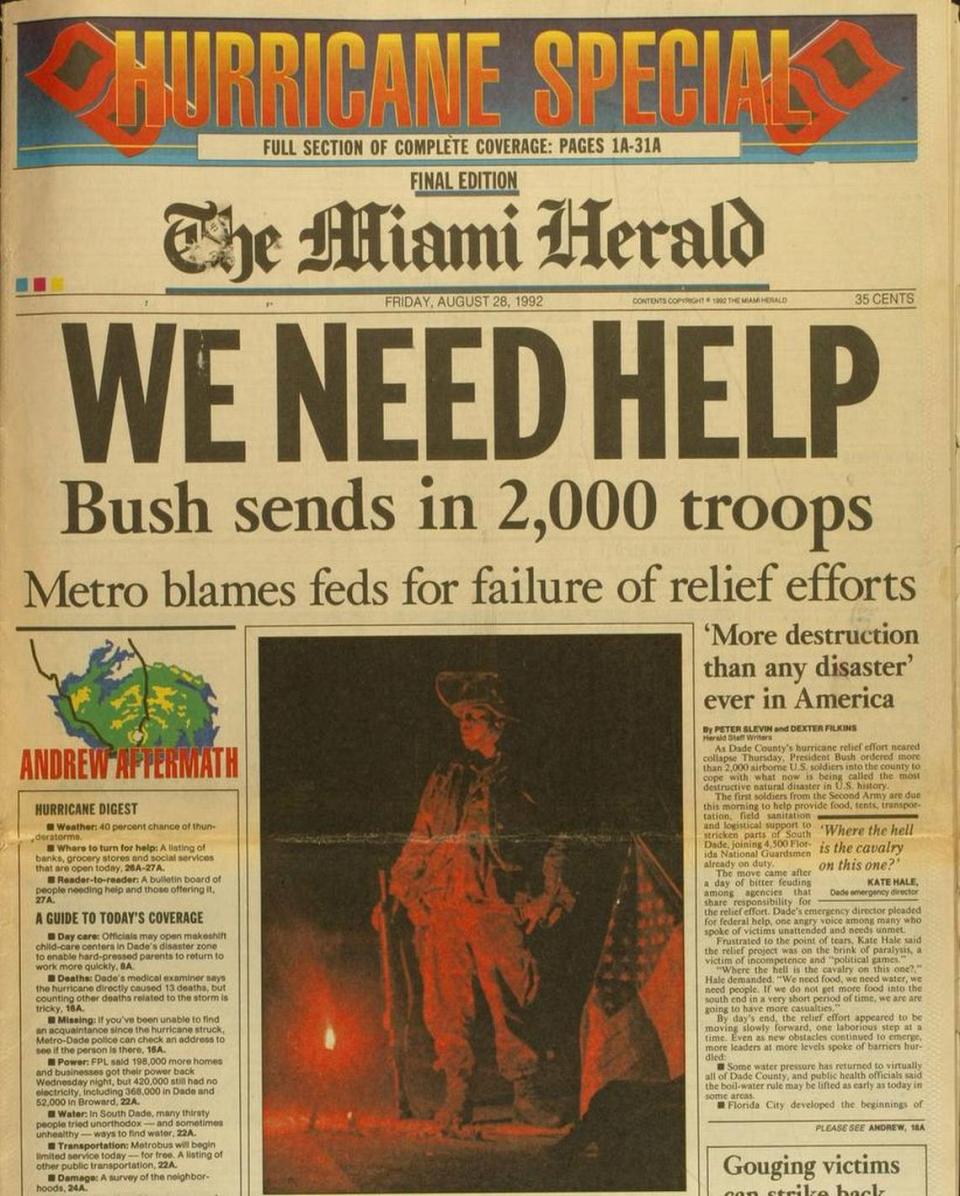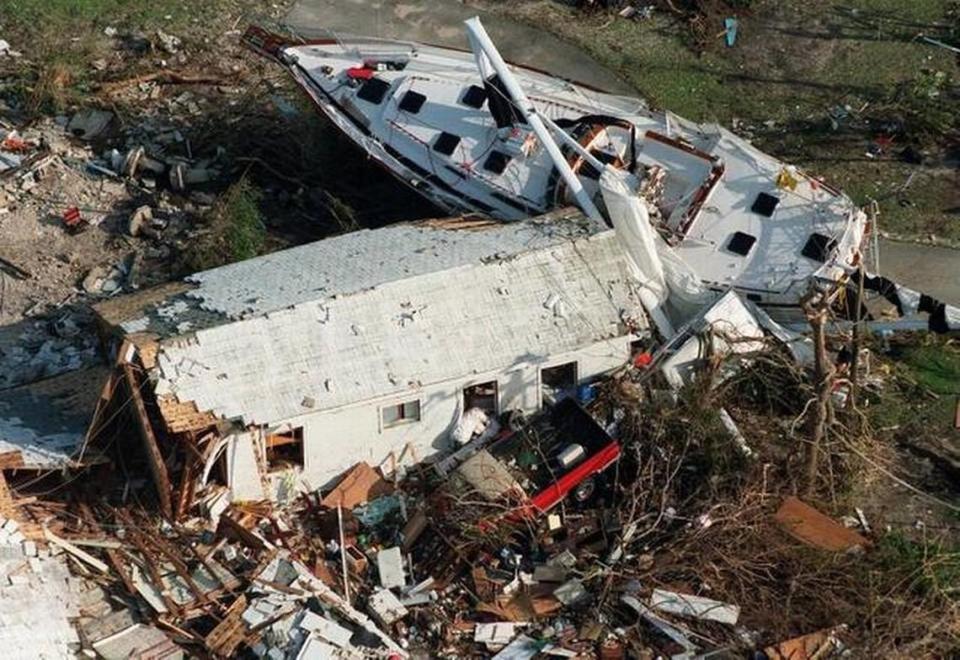Everything you need to survive a tropical storm or hurricane in Florida
Getting ready for a storm involves lots of details. Fridge-free food. Water. Batteries. Tree-trimming. Insurance. Evacuations and flood zones. Boat storage.
It’s easy to get overwhelmed with the list of things to do as we track an approaching storm’s path.
To help, we’ve compiled checklists by topic. Keep up to date with forecasts at https://www.miamiherald.com/news/weather/hurricane/
Key websites
Miami-Dade County Office of Emergency Management and Homeland Security (includes Red Cross shelters and other information): www.miamidade.gov/oem/. Call 311. Twitter: @MiamiDadeEM
Broward County Emergency Management Agency (includes Red Cross shelters and other information): www.broward.org/hurricane. 954-831-3900. Twitter: @ReadyBroward
Monroe County Emergency Management (shelters in Monroe County will close in category 3, 4 or 5 hurricanes; Residents must evacuate to the mainland): http://www.monroecounty-fl.gov/ 305-289-6018. Twitter: @MCSOnews

Emergency management websites
State of Florida Division of Emergency Management: www.floridadisaster.org. 850-413-9969 Twitter: @FLSERT
Federal Emergency Management Agency: www.fema.gov. 202-646-2500 Twitter: @fema
Federal Alliance for Safe Homes: www.flash.org. 850-385-7233. Twitter: @FederalAlliance
National Hurricane Center (includes storm tracking map, preparedness guide and other information): www.nhc.noaa.gov. Twitter: @NWSNHC
Citizens Property Insurance: www.citizensfla.com. 888-685-1555. Twitter: @citizens_fla
National Aeronautics and Space Administration Hurricane Resource Page: www.nasa.gov/ mission_pages/hurricane s/main/index.html. Twitter: @NASAHurricane
Florida Power and Light: www.fpl.com/storm: Features checklists, information on how to report an outage and check on its status as well as other preparation tips. DADE: 305-442-8770 BROWARD: 954-797-5000. Twitter: @insideFPL.

15 things to do in a Hurricane Watch
Begin listening for storm updates or check National Hurricane Center updates at www.nhc.noaa.gov.
Fill the car’s gas tank and keep it topped off. Make sure the battery is in good condition.
Fill propane tanks for gas grills and camp stoves.
Check your battery-powered equipment. A radio could be your only link with the outside world during and after a hurricane.
Review your preparedness plan with your household.
Pick two places for your family to meet: a spot outside your home in case of emergency, such as fire, and a place away from your neighborhood, in case you can’t return home.
Establish an out-of-town phone number with family or friends to relay messages about your whereabouts after the storm.
Refill prescriptions.
Stock canned foods, soft drinks and water.
Collect medical and property insurance papers, immunization records and medical records of anyone with special needs in a rugged, waterproof container. Include a few cherished mementos. If you evacuate to a shelter, take these items with you.
If you are not in an evacuation zone, determine your “safe room” or a room that is away from windows and has walls close together.
Put shutters, window and door protection in place if instructed by local officials.
Do not trim branches or limbs from trees. These could become dangerous missiles if picked up by the wind.
Locate the turn-off valves for electricity, water and gas.
Inspect and secure mobile home tie-downs.

12 things to do in a Hurricane Warning
Fill bathtubs and jugs with water. Figure on using a gallon of water per person per day.
Turn refrigerator and freezer settings to the coldest levels. Freeze water in plastic containers.
Bring in any outdoor objects that could become projectiles in high winds: mailboxes, garbage cans, lawn furniture and garden tools. Anchor anything that cannot be brought inside.
Install shutters or cover all your windows and doors. Install braces on your garage doors if they do not meet the building code.
Keep all windows closed during the storm.
Disconnect natural gas to individual appliances at the supply valves near each unit. Do not turn off the main gas line. Disconnect propane gas to individual appliances.
Remove external antennas.
Remove valuable pictures and bric-a-brac from walls.
Wedge sliding glass doors with a bar.
Draw drapes and blinds.
Lower the water level in your pool. Turn off electricity to the pool and cover the pump equipment with waterproof material. Store child safety fences.
Gather your hurricane kit and stay in your safe room. Essentials for the room include your hurricane kit, sturdy shoes, something to cover your head such as a pillow or mattress and a fire extinguisher.

5 food Things to Know
▪ Water: Plan to stock seven gallons of water per person. That should be enough for drinking and cooking for a week. You can buy bottled water, or, if you prefer, fill recycled glass bottles that you rinse with a little bleach. Don’t reuse plastic bottles; they can’t be made clean enough. When the storm approaches, fill buckets, the sink and tub with water to use for cleaning and washing only.
▪ Nonperishable food: Think crackers, string cheese, mini-cut carrots and salsa, hummus with bagel chips, unsalted baked chips, sliced apples or grapes and protein bars. Unsweetened cereals make crunchy healthy snacks as well as quick meals at times besides breakfast. Look for tuna in single-serving cans or pouches. Pork and beans comes in a variety of flavors, including country style, Boston recipe and vegetarian. And stock up on single servings of shelf-stable puddings, fruits and gelatins. Just remember to have a can opener.
▪ Food storage: Store all your emergency supplies in one place. Now is the time to start using the chops, steaks and other foods in your freezer. After the storm — when the refrigerator may not be working — have two large coolers or ice chests available. Place items you want to access often such as fruit and water bottles in one cooler; place longer-term items in the other cooler.
▪ Cooking: Stock up on charcoal or propane for your outdoor grill. Keep the grill away from an enclosed area to avoid carbon monoxide poisoning. A butane burner or camp stove is good for boiling water, but use only outdoors.
▪ Serving: Consume fresh fruits and vegetables and cook up any meats first. These will be the fastest items to spoil when the power goes out.
9 WAYS TO GUARD YARD
▪ Don’t trim before a storm; you will create dangerous projectiles.
▪ Remove coconuts, fronds and pick any fruit from trees.
▪ Bring potted plants and lawn furniture indoors.
▪ Stake small trees by driving rebar, wood or plastic stakes at least eight inches into the ground and attach them to the tree with rope or soft plastic bands.
▪ Cut back vines on fences so they don’t pull the structure over in high winds.
After the storm:
▪ Hose down any part of the landscape subjected to salt spray.
▪ Cut back broken branches to where there is clear wood.
▪ Raise downed trees if they are newly planted or have a trunk diameter less than four inches. For larger trees, consult a tree service.
▪ To replant, enlarge the hole, trim the roots, stand the tree back up and fill the hole with the original soil, tamping it down to remove air pockets. Stake the tree for a year and water it every other day for at least two weeks.
10 TIPS ON KEEPING SAFE WHILE POWERING UP
If a storm zaps power, crank up the generator safely:
▪ Keep a generator at least 10 feet from the opening to any building.
▪ Do not run it inside your house or garage, even if you have doors and windows open. If you live in a multi-unit building, don’t run it on your balcony — it’s too close to your living areas and to your neighbors’ homes.
▪ Never run a generator on grass, or on a metal surface. Use a concrete pad, and elevate the generator if you’re in a flood-prone area. Make sure the surface is dry before starting a generator, and always dry your hands before touching it.
▪ Read your generator’s manual carefully. Follow all directions and pay close attention to the electrical load rating. Make sure the generator is grounded.
▪ Use a heavy gauge, outdoor-rated extension cord to run into the house to power your refrigerator or other appliances. Be sure the extension cord can handle the wattage you send through it.
▪ Do not connect the generator to your home wiring system, fuse box or circuit breaker unless you have an electrician install a transfer switch. If not correctly connected, the power can flow outside the house to the power lines and fatally injure workers trying to restore power.
▪ Don’t exceed the recommended wattage. Don’t try to run high-wattage items like the air conditioner, an electric stove or hot water heater unless you’re sure your generator can handle it.
▪ Turn off all connected appliances before starting your generator. Let the unit reach operating speed before connecting anything. Start the largest electric appliance first, then plug in other items, one at a time.
▪ Never refuel a generator while it is running or still hot.
▪ Disconnect electrical loads before turning off the engine. Don’t allow the engine to run out of gas while appliances are connected.


